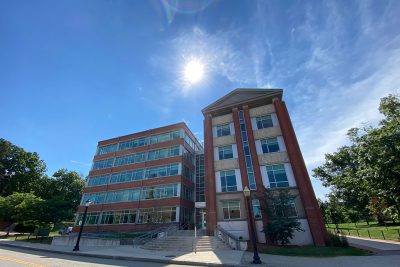
In 1940, the Connecticut Agricultural College became the University of Connecticut. That same year, a number of “schools” were established on campus, including the School of Education. Prior to that time, teacher training was considered a division. In 1999, the School of Education was renamed after Ray Neag to honor him for his $21 million gift to the School.
The home of the Neag School of Education is the Charles B. Gentry Building. The original structure, built in 1960, stands as a tribute to the leadership of devoted educator and administrator Charles B. Gentry, who served as director of the Division of Teacher Training until 1940 and, from 1921 to 1940, held the position of dean and twice served as the University’s acting president.
More than 40 years after its construction, the Gentry Building received a $10 million addition and facelift. Dedicated in Fall 2004, the home of the Neag School of Education became the first wireless building at UConn Storrs. The 20,000-square-foot wing added to the building’s west side was funded by the state’s UConn 2000 and 21st Century UConn budgets, as well as privately raised funds.
Up to that point, Neag School of Education faculty, staff, and classes were spread among several buildings. The number of people supported by grants had nearly doubled during the previous four years, but there was no space for them to work. The building had also been facing a variety of environmental challenges. The new wing brought new opportunities, including additional offices for faculty, staff, and graduate students; flexible space for accommodating large and small conferences and classes; high-tech conference rooms and classrooms, each equipped with interactive white boards; and an expansive atrium, which has become the heart of the School.
From the outside, the Neag School of Education’s new wing created a fresh architectural image for the campus, while also following environmentally green building practices. The Gentry Building and nearby Rowe Center for Undergraduate Education (formerly home of the School of Business) were designed as mirror images of each other when they were built in 1960. The additions to the twin buildings, designed by Svigals + Partners of New Haven, Connecticut, continue that effect. Sculpted panels on the facades of the buildings consist of figures interwoven with words and phrases created by using the 12 letters found in “University of Connecticut.” Sculptor Barry Svigals collaborated with UConn Fine Arts students and faculty members Randall Hoyt and Mark Zurolo to create figures that appear to be walking toward the heart of campus.
The Gentry Building addition was the beginning of a two-phase construction project. The second phase — a $10 million major overhaul and expansion of the original building — began in May 2009. Finished in early 2010, the Charles B. Gentry Building is now a comfortable, attractive home for Neag School faculty, staff, and students. The renovated space, which is architecturally compatible with the wing, was reconfigured to create additional faculty offices and meeting rooms. Through the expansion and renovation, the Neag School became fully integrated, bringing nearly all the School under one roof. With most of the faculty housed in the Gentry Building, collaboration and interdepartmental work also became easier.
In response to the expanded growth and momentum, the Neag School rose in the rankings, according to U.S. News & World Report, reaching the top 10 percent among all public graduate schools of education. Numerous programs within the Neag School have also achieved national ranking among the top 25 over the years, including special education, elementary teacher education, secondary teacher education, educational leadership, and educational psychology, among others.
In 2012, President Herbst announced an ambitious plan to hire and recruit faculty who would have a significant impact on research, scholarship, and funding within and across UConn’s Schools and Colleges. As a result of this hiring initiative, the Neag School of Education brought in 17 new faculty, consisting of a mix of junior and senior professors recognized across the nation as top scholars in the field of education and workforce development.
Combining the Neag School’s outstanding new faculty hires with the School’s already nationally recognized faculty brings great promise to what the Neag School will accomplish with respect to meaningful, nationwide education reform.
In conjunction with UConn’s new Academic Vision process in 2014, the Neag School undertook a thoughtful and comprehensive process to develop the School’s Academic Plan. The Strategic Planning Committee put forth four areas of research strength and opportunity to position the school to play a leadership role at UConn, the state of Connecticut, the nation and the world:
- Equity and Social Justice
- STEM Education
- Creativity and Innovation
- Educator Quality and Effectiveness
Neag School of Education Leadership History
- 1919-21 — Theodore Eaton, Dean of the Division of Teacher-Training
- 1921-40 — Charles B. Gentry (Namesake of the building housing the Neag School)
- In 1940, the Division of Teacher-Training became the School of Education.
- 1940-48 — P. Roy Brammell
- 1948-49 — William Gruhn (acting)
- 1949-60 — P. Roy Brammell
- 1960-61 — C.A. Weber (acting)
- 1961-64 — F. Robert Paulsen
- 1964-65 — Glenn C. Atkyns (acting)
- 1965-72 — William H. Roe
- 1972-75 — Harry J. Hartley
- 1975-87 — Mark R. Shibles
- 1987-88 — David N. Camaione (acting)
- 1988-96 — Charles W. Case
- 1996-97 — Judith A. Meagher (acting)
- 1997-2009 — Richard L. Schwab
- In 1999, the School of Education became the Neag School of Education.
- 2009-14 — Thomas C. DeFranco
- 2014-16 — Richard L. Schwab
- 2016-21 — Gladis Kersaint
- 2021-Present — Jason Irizarry
